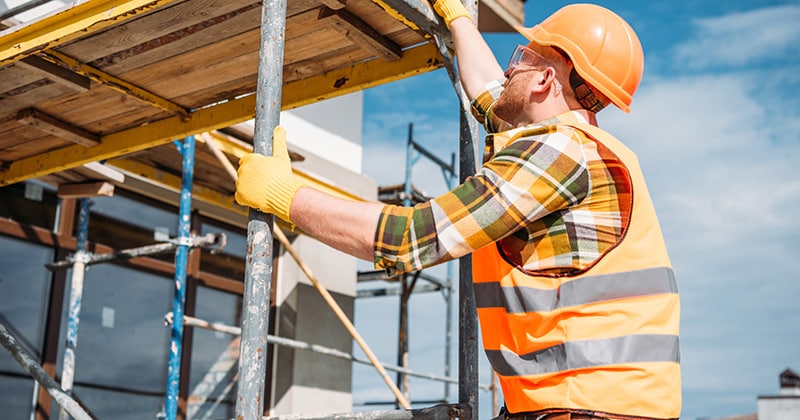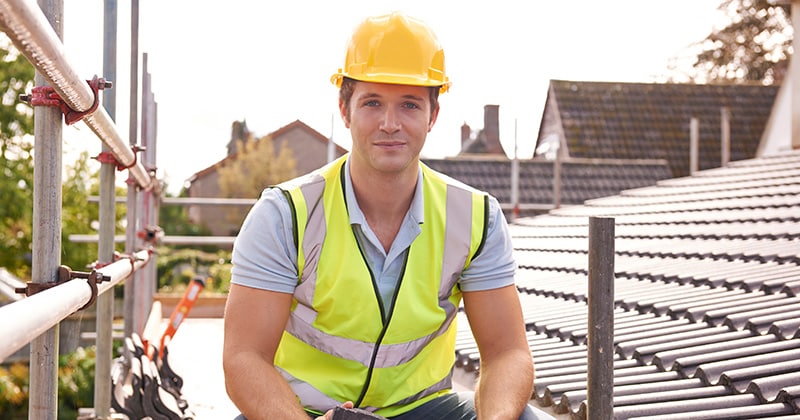Scaffolds come in all shapes, sizes, and configurations. With so many designs, brands, and models to choose from, it can be hard to find the best scaffolding for various contracting applications.
To most people, scaffolding is just an unsightly mess. But the truth is, scaffolding is much more important than it’s given credit for.
You may also have heard scaffolding referred to as scaffold or staging. It is indispensable when doing general contracting jobs. Whether you’re a builder, roofer, remodeler, or painter, you’ll need a raised platform.
The crew needs a place to stand with their supplies and tools when working on hard-to-reach areas. Additionally, scaffolding guarantees the crew’s safety. And it makes the job so much easier.
RELATED ARTICLE: How to Start a Painting Company in 9 Steps
The idea of using scaffolds is not new. Archeological evidence suggests that primitive scaffolding was used to paint cave walls some 15,000 years ago.
Today, scaffolding has evolved into a multi-billion-dollar commercial industry. There are countless scaffolding designs, brands, and models.
In fact, the world of scaffolding can be confusing, even to contractors. There are so many types, materials, and configurations to choose from. The big question is, what’s the best scaffolding?
“Best” is a subjective term. We can’t place just one type, brand, or model of scaffolding on a pedestal and call it the best. So, we’ve rounded up six of the best scaffolds for professional contractors.
This list is based on thorough research. It spans customer reviews, affordability, practicality, safety, and ease of use.
This article also explains the various types of scaffolding available and their applications. You want to ensure you get the proper scaffolding for the job at hand. Plus, we’ll tell you what to look for when buying commercial scaffolds.
Let’s get started.
The Different Types of Scaffolding

Before discussing the various types of scaffolding, it’s important to understand some common scaffold lingo. Here’s a quick rundown of the terminologies we’ll be using to describe scaffolding throughout the article:
Subject
The subject is the structure being built, painted, repaired, cleaned, or remodeled. It could be a wall, building, pillar, roof, etc.
Platforms (work platforms or boardings)
These are the flat surfaces the crew stands, sits, or walks on when doing their job. They also hold the crew’s supplies, equipment, and tools. Platforms are typically secured along ledgers.
Standards, Ledgers, and Braces
Standards, ledgers, and braces are the supports for the scaffolding.
Standards are the pieces running vertically from the ground to the top of the subject. They anchor the scaffolding to the ground.
The horizontal support pieces that attach to the standards are the ledgers. They are the main support for the platforms.
And braces are the pieces running diagonally between the standards and ledgers. These are there to provide extra stability and support.
Putlogs
Putlogs are pieces that attach the scaffolding to the subject. The putlogs also support the platforms.
Guardrails
Guardrails are barriers to prevent falls. They run the length of the work platform. Top rails are fitted above the chest level, while mid rails run at the waist level.
Ladder
The ladder is the climbing structure. It allows workers to ascend and descend the scaffolding and move in between platforms.
Not all scaffolding setups are going to have all these parts and features. But we’ll get to that in a moment. With the basic terms out of the way, we can get into the different types of scaffolding.
For starters, scaffolding comes in all shapes and sizes. And there can be numerous distinctions depending on how you categorize them.
But generally, here are the seven main types of scaffolding you need to know:
Single and Double Scaffolding
Single/double scaffolds are more of a scaffolding layout than a type of scaffolding.
Single scaffolding is also known as bricklayer scaffolding. It’s the simplest and probably the oldest scaffolding design. It features standards, ledgers, putlogs (going through holes in the subject), and work platforms.
In single scaffolding, only one row of standards anchors to the ground next to the subject. Double scaffolding, on the other hand, has two rows of standards for extra load-bearing support.
These scaffolding setups are commonly used in masonry.
Modular Scaffolding
Modular or system scaffolding are structures made from specially designed components. All the standards, ledgers, platforms, etc., are assembled on-site. They’re created from pre-fabricated modular units such as joints, locks, latches, and metal tubes.
System scaffolds are of different types. Common examples include:
- Ringlock scaffolding
- Cuplock scaffolding
- Haki scaffolding
- Kwikstage scaffolding
- Shoring scaffolding
- Frame scaffolding
Modular scaffolds are used to construct complex structures. They are also highly flexible and scalable. Flexibility allows for unique scaffolding setups to suit a wide range of applications and jobsites. But they are generally used in heavy construction projects.
Tubular Scaffolding
Tubular scaffolding is sometimes also called tube and clamp scaffolding. It is a traditional scaffolding system consisting of steel tubes joined together with bolted clamps. But unlike modular systems, the tubes and clamps are not purpose-built for scaffolding.
In some projects, you may find bamboo being used in place of steel tubes. Bamboo is preferred over steel for its flexibility, lightweight, and low cost. The trunks are tied together using wires and ropes instead of clamps.
Tubular scaffolding is ideal for general construction purposes. It’s also used when painting high walls and fitting ceiling boards.
Suspended Scaffolding
Suspended or floating scaffolding is a staging structure that hangs from one or more points on the subject. The platform is supported and moved using a rope-and-pulley system, often powered by a small motor.
There are several types of suspended scaffolding. These include:
- Swing stage scaffold
- Multi-level suspended scaffolding
- Interior hung scaffolding
- Catenary scaffolding
- Float/ship scaffolding
- Bosun’s chair
Suspended scaffolding is used for light contracting jobs. Painting, window repair, window cleaning, and HVAC repairs/installations are good fits.
Cantilever Scaffolding
Cantilever scaffolding is also called needle scaffolding. In this setup, the platform (needle) protrudes at right angles from the subject.
The scaffolding doesn’t have standards to anchor it to the ground below. Instead, the platform is supported by suspension cables and/or angled braces attached to the subject.
This type of scaffolding is used in sites that can’t support ground-anchored scaffold standards. They are also used by roofers.
Trestle Scaffolding
This is a simple make-shift scaffolding structure. Instead of standards, the platform is elevated and supported by ladders or tripods.
Trestle scaffolds are used in light jobs, mainly painting and plastering.
Mobile Scaffolding
This category includes all types of portable scaffolds. These are scaffolds resting on caster wheels or a powered platform. Aerial lifts such as telescopic scissor platforms also count as mobile scaffolds.
Mobile scaffolding is ideal for jobs that require a lot of movement.
FROM ONE OF OUR PARTNERS: DIY Social Media Marketing for Contractors with Zero Budget
What to Look for in Commercial Scaffolding

Your choice of scaffolding can make all the difference in a contracting project. Using suitable scaffolds improves your crew’s safety, efficiency, and productivity.
However, choosing the right scaffolding can be daunting, especially if you’re new to contracting. But don’t worry. The following pointers will guide you to find the best scaffolding for any contracting project:
Compliance with Safety Standards
We always say “safety first” when it comes to contracting jobs. Any job requiring scaffolding is inherently dangerous.
According to the Occupational Safety and Health Administration (OSHA), scaffolding-related accidents account for 4,500 injuries and 50 deaths every year.
Most scaffolding-related accidents are easily avoidable. You just need a scaffolding setup that addresses all safety concerns.
First, check that the scaffolding meets industrial and regulatory safety standards. Compliance with OSHA’s 1926.451 – General requirements or ANSI/ASSP A10.8-2019: Scaffolding Safety Requirements is a good indication of safety.
Second, ensure the scaffolding’s application fits within the manufacturer’s safety margins. Check that it will be sufficiently safe for the intended use, worksite, and load capacity.
Ease of Installation and Use
How easy is it to install and use the scaffolding?
Some scaffolds are easier to work with than others. For instance, a simple trestle scaffolding structure takes barely any time or skill to set up. On the other extreme, assembling a modular system can take days and may require specialized skills and equipment.
However, remember that practicality trumps simplicity. Trestle scaffolds may be simple. But you can’t use them to build a three-story house. You have to balance those two aspects perfectly.
Keep the scaffolding as simple as you can. But do so without compromising safety or workability. A scissor lift might make more sense when painting a small building than setting up a suspension system.
Compatibility with the Jobsite
Different types of scaffolding are meant for different worksites. Choose a scaffolding system that fits or can be adapted for the intended jobsite.
Here are a couple of things you need to consider about your worksite before purchasing scaffolding:
- The height of the subject
- The kind of work being done
- The load that will be placed on the scaffolding
- The level of access required in or around the subject
- The size of the crew working on the project
- The stability of the ground where the standards will anchor
- Any miscellaneous constraints, such as space limitations
Ensure the scaffolding can adapt to match the site’s or project’s requirements. If you’re working on a five-story building above a busy street, you might not be able to install scaffolding requiring ground anchors. You’d be limited to suspension or cantilever scaffolds.
RELATED ARTICLE: The 12 Best Roofing Shoes for 2023
Affordable Price and Good Return on Investment
You’ll also want to consider the cost when buying a scaffolding system. But not so much the price tag but the value the scaffolding brings to your business versus what it costs.
Obviously, different scaffolding types, models, and brands are priced differently. A suspension scaffold can be many times less expensive than modular structures. However, less expensive doesn’t always mean better value.
Let’s take the case of modular scaffolds as an example. They might cost more than most alternatives. But they are vastly more versatile, flexible, and scalable. They can be used again and again in many different projects.
Meanwhile, though cheaper, suspension scaffolds may only be good for very specific projects.
For a builder with a large crew that gets a lot of masonry jobs, investing in high-end modular, tubular, or cantilever scaffolding might be the right economic choice. Again, scaffolding economics depend on the scaffolding’s intended purpose.
Calculate the scaffolding’s ROI to see if the cost is justified.
Factor in its:
- Useful lifespan
- Utilization rate
- Potential earning or cost savings
Warranties and Guarantees
The various components in a scaffolding structure have a finite lifespan. For instance, untreated plywood boards can stay outside for up to five years. But metal tubes and couplings are rated between 15 and 20 years.
But can the manufacturer guarantee that the scaffolding will actually last this long?
Check whether the manufacturer offers reasonable warranties. While at it, ask about safety and satisfaction guarantees as well.
Product guarantees and warranties are an indication of quality and durability.
Crew Satisfaction
It helps to get your crew involved in choosing the best scaffolding. After all, the scaffolding is meant for use by the crew.
Get all crew members to offer suggestions. What’s the safest, most practical, and easy-to-use scaffolding? You might get valuable insights into the functions that really matter on the job.
Side note: Getting the crew involved in such important decisions builds morale. It goes a long way in making every crew member feel valued and cared for.
FROM ONE OF OUR PARTNERS: SEO for Roofing: 5 Best Practices to Implement
6 Scaffolding Options to Consider

Now you’ve learned all the different types of scaffolds. You know what to look for when buying a scaffolding system. It’s time to hit the shops.
Here’s our top-6 list of the best scaffolding for professional contractors:
Metaltech’s JOBSITE SERIES™ 6′ Baker Trapdoor
The Baker Trapdoor is part of Metaltech’s JOBSITE SERIES™, a family of portable general-purpose scaffolding units.
The structure is laid out in four standards, five ledgers for each pair of standards, and a wooden height-adjustable platform. The alloy steel structure weighs about 130 pounds. It can support up to 1,000 pounds. Dimensions are 74.75 x 29.75 x 75 inches with a max height of 3 feet.
The product’s defining characteristic is right there in the name. One end of the platform has a cleverly designed trapdoor. This can be used as a supply chute. And it’s wide enough for a worker to climb through.
Baker Trapdoor is ANSI, CSA, and OSHA compliant.
Given the scaffolding’s dimensions and its set of caster wheels, it is ideal for painting, cleaning, and light repair jobs.
Werner’s Scaffold NSRS-72MP
The NSRS-72MP is quite similar to the Baker Trapdoor by Metaltech. It’s a rolling scaffold made of steel standards and ledges with a plywood platform. It features two work shelves, one above and one below the platform, but lacks the trap door.
The unit measures 76.8 x 32.4 x 72 inches, weighs 162 pounds, and holds up to 1,250 pounds. It’s also ANSI and OSHA certified.
This multi-purpose, light-duty scaffolding is ideal for painting, installing ceiling boards, or plastering walls.
Metaltech’s JOBSITE SERIES™ 4′ Safety Rail & Tool Shelf
This is another versatile, portable, lightweight scaffold from Metaltech.
It measures 49.5 x 22.5 x 57.75 inches and has a maximum reach of 9 feet. The entire frame is made from steel, including the two non-slip platforms. It also comes with a plastic side shelve and a front guardrail.
Like all Metaltech scaffolds, the JOBSITE SERIES™ 4′ Safety Rail & Tool Shelf is ANSI, CSA, and OSHA compliant.
Each of the two platforms can handle up to 250 pounds, giving it a total carrying capacity of 500 pounds. Given its load capacity, flexibility, and unlimited mobility, this scaffolding is best suited to light work involving a lot of movement.
Little Giant’s Adjustable Safety Cage™
The Adjustable Safety Cage™ is more than just a fancy step ladder. If anything, it’s probably the most versatile light-duty scaffold you can buy.
It measures 45.5 x 115 inches, with the platform maxing out at 9 feet. Even though it’s smaller, it has a 375-pound carrying capacity.
Admittedly, it’s designed like a step ladder. But no stepladder has the following combination of clever features:
- A frame made of strong, lightweight fiberglass
- Height-adjustable guardrail-contained bucket at the top allowing 360° movement
- Each side rail’s height can be adjusted independently of the other
- Two pairs of telescoping outriggers on either side
- Side rails with lockable wheels
This is clearly the Swiss Army knife of professional ladders and mobile scaffolds. It’s a faster, compact, and more economical alternative to motorized scissor lifts.
Since the Adjustable Safety Cage™ is highly maneuverable, it can be used over uneven surfaces, including stairways. It’s best suited to light contracting work.
TheScaffoldWarehouse.com’s 21′ Ring Lock System Scaffold Stair Tower
For $5,450, TheScaffoldWarehouse.com will send you a kit to build a 21-foot-tall ringlock scaffold stair tower. The kit will contain over 100 components. It includes ring standards, braces, couplings and connectors, ledgers, ladders, and guardrails.
All the components are built to ANSI/SAIA A11.1 load standards. Once assembled, the kit makes a robust scaffold capable of handling multiple workers. It should also hold supplies and equipment on a construction site.
FROM ONE OF OUR PARTNERS: Why Contractors Should Partner with Suppliers
Badger Ladder’s Tube & Clamp Scaffolding
If you’re looking for heavy-duty scaffolds, Badger Ladder’s tubular scaffolding is another option worth considering.
The company sells OSHA and ANSI-certified tubular scaffolding on a piece-by-piece basis. You have a choice of tubes ranging from T-4 to T-16, with prices starting at $26.
This approach works if you want a versatile scaffolding. The tubes and clamps can be joined in any configuration to suit jobsite requirements.
Badger Ladder’s scaffolds are meant for heavy-duty construction, repair, or remodeling projects.

